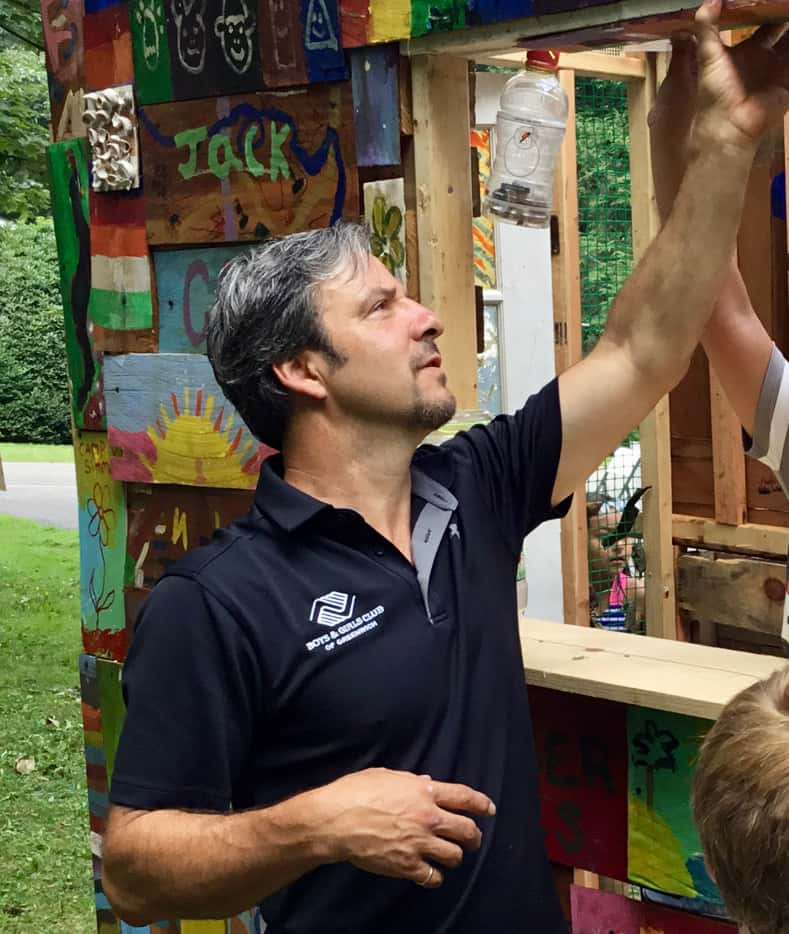
By Michael Manning

GET OUT OF THE BOX WITH A BACKYARD ART STUDIO!
The summer is one of the best times of year to fully enjoy the creative process. Not just because of the more relaxed atmosphere but also because you can have an instant art studio right in your own backyard. Kids are now free to work outside without the concern of spills and the mess which sometimes come with creating art on the dining room table. This year with the COVID-19 environment, the outside art studio is even more important.
During the summer months, keeping your child engaged in the creative process for hours only takes a few things: a little creativity, a designated backyard art studio space and the use of new materials to create a completely fresh approach to art and to each project.
First, create or designate a space that will be the new outdoor studio. The front and backyards as well as other outside spaces are great as they provide your young artist a space where they don’t have to worry about making a mess. It doesn’t have to be a large space, just a space that they can call their own and play with materials and ideas. This space will foster a creative mindset and can become a world of its own.
Next, introduce new materials. This can be one of the easiest ways to get your child to engage in the creative process. It’s important to remember that art can be made of absolutely anything. Your basement, garage and attic, are great places to find objects to get your child thinking about the endless possibilities of art. Old Amazon boxes, recycled water bottles, old clothing, toys that are about to be thrown away; each of these can be turned into unique pieces of art. Use zip ties to assemble your work since they are strong, flexible and easy to cut apart with scissors. By giving your child new material, you’re creating a problem solving challenge, drawing on their innate creativity.
Here are some of the most popular projects I’ve done with children in Greenwich Public Schools and the Boys & Girls Club Camp Simmons. First, a recycled chandelier. All it takes is some recycled water bottles, hot glue to connect the bottles, clear packing tape to shape it and string to hang it. Create the chandelier with these everyday items, add some glow sticks as lights and your child will be thrilled to hang it up in their room.
Another popular project is to use cardboard boxes to create giant dogs, mythical creatures, robots and anything your child can imagine. Or encourage your child to use boxes to make a bed and house for their stuffed animals.
Here are some of my go-to items for art projects:
If you’re looking for larger boxes, head to your local bike shop where they will be happy to help with your child’s creative endeavors.
For cutting cardboard a safe tool that I like to use is a Canary cardboard cutter, which is basically a double sided butter knife. You can find it on Amazon for only $8.
For painting, instead of using regular 8” x 10” pieces of paper, pick up a fifty yard roll of Red Rosin paper at Home Depot which is typically used for flooring. The cost is only $14 and is some of the best paper you can buy for creating large scale works of art. One of my favorite things is to roll out two pieces and glue them together so in the end we have a surface that’s 6 x 7 feet to work on. Put it out in the backyard and your child will truly love working on a larger scale.
For paint, don’t spend a lot. Just use a primary set of tempera paint in the gallon size which is about $16 on Amazon or any art supply shop. It’s much less expensive and with the freedom of more materials, your child will be able to be even more expressive in their work.
Sidewalk chalk is just $6 for a large box of 48 pieces of chalk. This also works well with large format drawings and is great to mix with tempera paint.
More than anything, remember that everyday spaces like your backyard and everyday objects that you would otherwise discard are perfect ways to discover your inner artist. Each of these projects will keep your child engaged for hours and give them an opportunity to explore new materials, problem solve and simply have a ton of fun. Don’t forget to add some music and shrug off the mess as your child creates amazing works of art!
Michael Manning is a professional studio artist and educator. He is currently co-leading the Developing Artist Program funded by the Greenwich Alliance for Education, The CT Office of the Arts and the National Endowment for the Arts. His artwork has been part of numerous regional and international exhibitions, solo and group exhibitions in Haus der Kunst Museum in Munich, Germany; Arnot Art Museum, Elmira, NY; University of Connecticut; Seton Hall University and the Flinn Gallery, Greenwich, CT. Michael also runs the art programs for the Boys & Girls Club and is the Art Depart Chair at a high school in NY.




